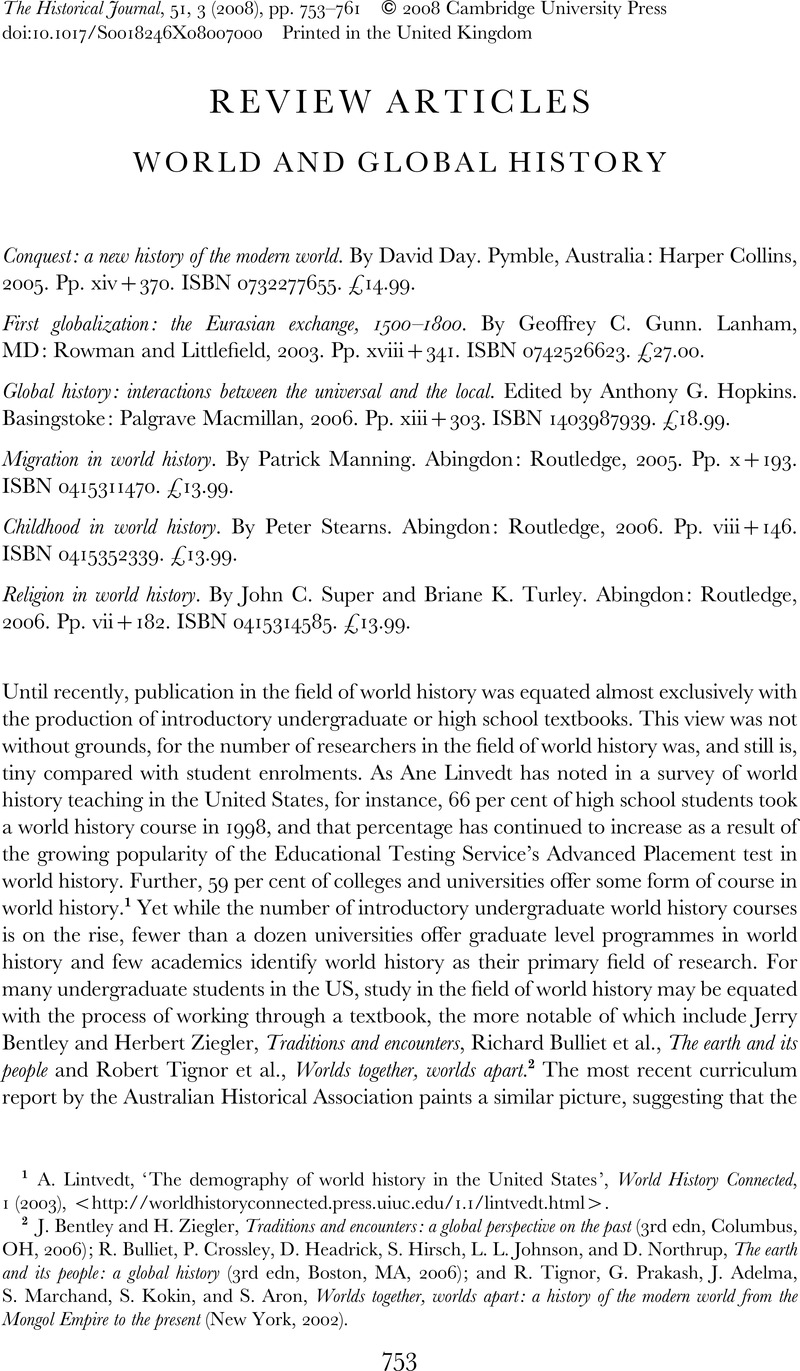Article contents
WORLD AND GLOBAL HISTORY
Published online by Cambridge University Press: 04 September 2008
Abstract

- Type
- Review Article
- Information
- Copyright
- Copyright © 2008 Cambridge University Press
References
1 A. Lintvedt, ‘The demography of world history in the United States’, World History Connected, 1 (2003), <http://worldhistoryconnected.press.uiuc.edu/1.1/lintvedt.html>.
2 J. Bentley and H. Ziegler, Traditions and encounters: a global perspective on the past (3rd edn, Columbus, OH, 2006); R. Bulliet, P. Crossley, D. Headrick, S. Hirsch, L. L. Johnson, and D. Northrup, The earth and its people: a global history (3rd edn, Boston, MA, 2006); and R. Tignor, G. Prakash, J. Adelma, S. Marchand, S. Kokin, and S. Aron, Worlds together, worlds apart: a history of the modern world from the Mongol Empire to the present (New York, 2002).
3 Millar, C. and Peel, M., ‘Canons old and new? The undergraduate history curriculum in 2004’, History Australia, 2 (2004), p. 14.6Google Scholar.
4 See for example P. Steinberg, The social construction of the ocean (Cambridge, 2001); B. Klein and G. Mackethane, eds., Sea changes: historicizing the ocean (New York, NY, 2004); S. Bose, A hundred horizons: the Indian Ocean in the age of global empire (Cambridge, MA, 2006); and Wigen, K., ‘Oceans of history’, American Historical Review, 113 (2006), pp. 717–21.CrossRefGoogle Scholar
5 See also Manning, P., ‘Homo sapiens populates the earth: a provisional synthesis, privileging linguistic evidence’, Journal of World History, 17 (2006), pp. 115–59CrossRefGoogle Scholar.
6 P. Bellwood, First farmers: the origins of agricultural societies (Oxford, 2005); and B. Heine and D. Nurse, eds., African languages: an introduction (Cambridge, 2000).
7 P. Aries, Centuries of childhood (New York, NY, 1962).
8 See for example L. Pollock, Forgotten children: parent–child relations, 1500–1900 (Cambridge, 1983); and L. Stone, The family, sex and marriage in England, 1500–1800 (Harmondsworth, 1990).
9 See for example W. H. McNeill and J. R. McNeill, The human web: a bird's eye view of world history (New York, NY, 2003).
10 K. Jaspers, The origin and goal of history (New Haven, CT, 1953).
11 L. Febvre, The problem of unbelief in the sixteenth century: the religion of Rabelais (Cambridge, MA, 1983).
12 B. Bryson, A short history of nearly everything (New York, NY,2004); E. Gombrich, A little history of the world (New Haven, CT, 2005); A. Toynbee, A study of history (12 vols., Oxford, 1934–61); and O. Spengler, The decline of the west (2 vols., New York, NY, 1922).
13 T. Ballantyne and A. Burton, eds., Bodies in contact: rethinking colonial encounters in world history (Durham, NC, 2005).
14 K. Pomeranz, The great divergence: China, Europe and the making of the modern world (Princeton, NJ, 2000); and A. G. Frank, ReOrient: global economy in the Asian age (Berkeley, CA, 1998).
15 R. Connell, Southern theory: the global dynamics of knowledge in social science (Crows Nest, NSW, 2007), p. 55.
16 See for example A. Curthoys and M. Lake, eds., Connected worlds: history in transnational perspective (Canberra, 2006), p. 15.
- 1
- Cited by


